I offer this reference guide to Chinese coins with the hope of promoting greater understanding and appreciation of these coins but THIS IS NOT A LIST OF COINS I CURRENTLY OFFERED FOR SALE.
Images represent the types and may be larger or smaller than the actual coins.
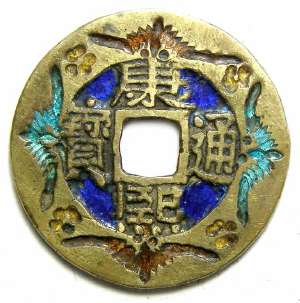 | THE CH'ING DYNASTY | 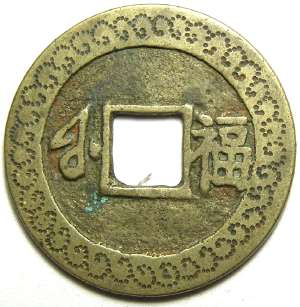 |
This is a reference guide only for Chinese coins issued by the Ch'ing Dynasty, not an offering of coins for sale. At this time, this page is far from complete with many even common mint marks missing, but it will help you identify all of the rules and many of the mint marks. Joe Lang has given me permission to use images and information from Steven Album rare coins, mostly from their auction results, so I will be adding types and information over time.
Images on this page represent types only, and bear no relationship to actual sizes. When two or more reign titles used the same mint mark, we normally use the same image of the mint mark for all of them, which speeds up download times, but means that some of the mint marks on the actual coins will have stylistic differences from the images used.
During the mid 1500's the Manchurians rebelled against the Ming Dynasty and in AD 1559 Nurhachu (also know as T'ai Tsu) established a small Manchu dynasty. By 1625 Nurhachu has gained enough territory to need a capital which he established at Mukden. He died a year later and was the throne passed to his son Abahay, also known as T'ai Tsung. Abahay changed the Dynastic name to Ch'ing in 1638 and on his death in 1644 the throne passed to his nine year old son Shih Tsu (know as Shun Chih). By then the Ch'ing controlled large parts of China but only in 1681 did they defeat the last "Ming Rebels" to take full control.
Most references date the start of the Ch'ing dynasty to 1644 when Shih Tsu's came to the throne but that is a very arbitrary date. One could place it at 1559 when Nurhachu established the Dynasty that became Ch'ing, or in 1638 when his son officially changed the name to Ching, or even in 1681 when the Ch'ing finally took control of all China. This is why I include the coinage of Nurhachu and his decendants in the Ch'ing Dynasty section.
The Ch'ing Dynasty was a period of enlightenment, with the arts and literature reaching a high point under the Emperors K'ang Hsi and Ch'ien Lung. This was also a period of increased interaction with the Western powers who, while gaining significant influence in China, failed in their efforts to colonize China.
The coinage of Ch'ing is fairly straightforward, and with one exception the Ch'ing Emperors used only one reign title each on their coins, which is why they are better known by their reign titles than their real names.
The obverse's of the coins conform to a fairly standard types with an obverse listing the reign title along with the words "T'UNG PAO" (money) in Chinese characters. The reverses vary over time. Under Shun Chih (1644 to 1662) the mint marks on the reverse are normally a single character in Manchu script, although at the end of his reign we some coins issued with "BOO" (meaning mint) and mint name, both in Manchu script. Under K'ang Hsi most reverse types have the mint mark twice, on the left in Manchu script and on the right in Chinese characters, although for the two principle mints in Beijing continued the "BOO" and mint name in Manchu. Most coins after K'ang Hsi, use the "BOO" and mint name in Manchu reverse type, with some later issues having extra characters in Chinese to denote additional information (denominations or dating).
To aid people trying using this page to identify an unknown coin, the following table shows all of the major obverse types, which you can click on to go directly to the section discussing that reign title.
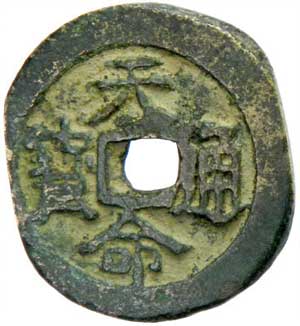 |
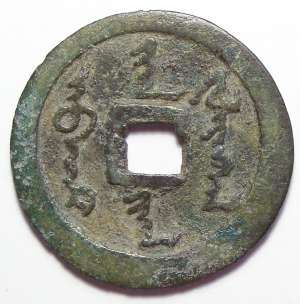 |
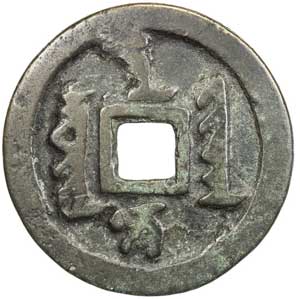 |
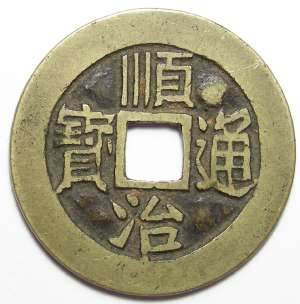 |
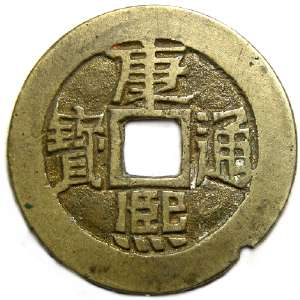 |
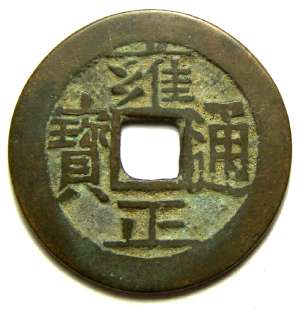 |
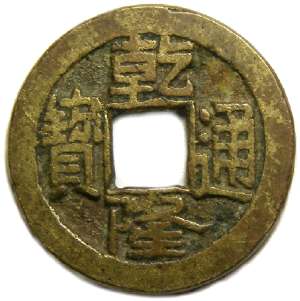 |
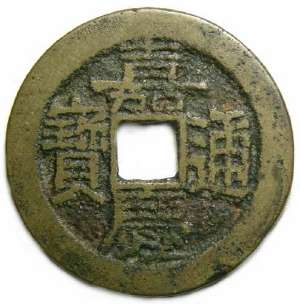 |
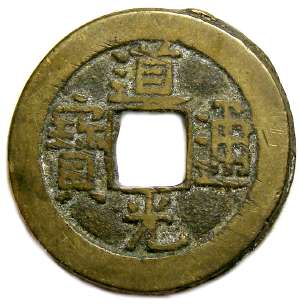 |
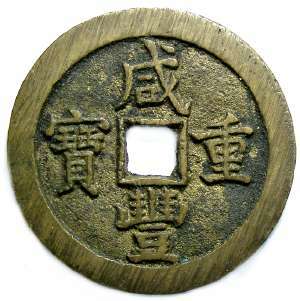 |
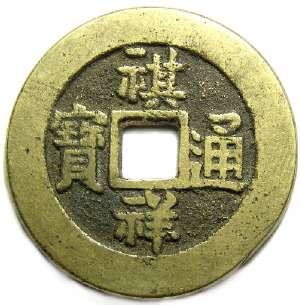 |
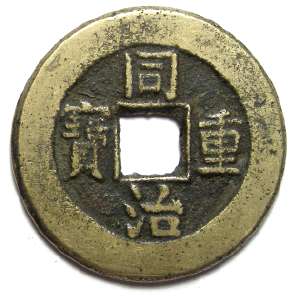 |
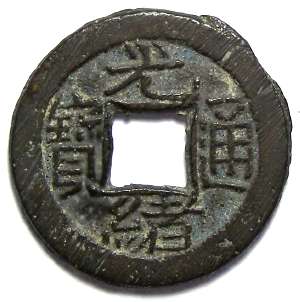 |
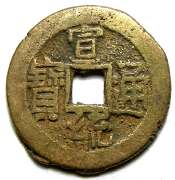 |
Note that for the Hsien Feng issue (row 3, column 1) there are other characters that can occur on the right side.
Emperor NURHACHU (T'AI TSU)
1559-1626
Reign title: T'ien Ming, AD 1616-1626

S-1356. Bronze 1 cash. Obverse: "T'IEN-MING T'UNG-PAO" in Chinese orthodox script. Reverse: this type is only found with a blank reverse, which may or may not have an outer rim. The casting is sometimes weak and poorly formed around the edges. The price below is for a well cast example.
gF $250.00 VF $375.00
S-1355. Bronze 2 (?) cash. Obverse: "ABKAI FULINGGA HAN JIHA" in what was at that time a newly invented version of Manchurian script (Manchurian for "Imperial coin of the Heavenly Mandate"). Reverse: blank. Average (2 specimens) 29 mm, 7.5 grams. These vary in weight quite a bit and are fairly crudely cast with poorly or unfinished rims and course unfinished surfaces.
F $100.00 VF $200.00 gVF $275.00This issue was first cast in about 1616 under Nurhachu, but continued to be cast throughout the reign of Abahay. The large size and heavy weight suggest this was intended to be of value 2 cash.
Emperor ABAHAO
1627-1643
Reign title: Shure Han, AD 1627-1643>

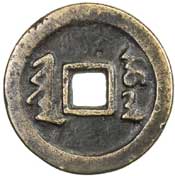
Hartill-22.8. Bronze 10 cash. A large coin of about 44 mm. Obverse: "SURE HAN NI JIHA" (Sure Khan's money) in Manchurian script. Reverse: Juwan Em Yan meaning 10 cash, one (silver) liang). Rare.
VF $3000.00Emperor SHIH TSU
AD 1644-1661
reign title: SHUN CHIH, AD 1644-1661

FIRST SERIES
The first series has a blank reverse, and was probably only issued in 1644.
S-1359, Reverse: blank. F $3.50 VF $6.00
SECOND SERIES
The second series was issued from 1644 until 1652. The reverse has the mint mark only as a single Chinese character which can occur either at the top or on the right side.
S-1363, "HO" (Honan mint) at the top. F $15.00 VF $25.00
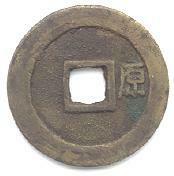
S-1370, "YUAN" at right (T'ai Yuan Fu in Shansi).
F $14.50 VF $20.00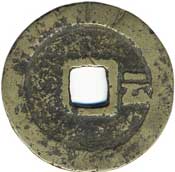
S-1373. "YUN" (Mi-yun in Chihli).
F $15.00 VF $35.00S-1377, "NING" (Ningpo mint). F $18.50 VF $37.50
S-1378, "CHE" (Chekiang mint) at the right. F $15.00 VF $22.50
S-1379, "CHE" (Chekiang mint) at the top. F $15.00 VF $25.00
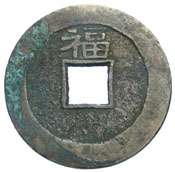
S-1382, "FU" at top (Fukien mint).
F $17.50 VF $35.00THIRD SERIES
The third series starts in AD 1653 but it is uncertain when it ends. The mint name is always on the right with "YI LI" (meaning 1 thousandth of an ounce (tael) of silver) on the left.
S-1392, "CHIANG" (Chiang-ning mint). F $15.00 VF $25.00
S-1395, "TUNG" (Shantung mint). F $12.50 VF $17.50
S-1399, "CHI" (Chi-chou in Chihli). F $25.00 VF $49.50
S-1401, "CH'ANG" (Wuch'ang mint). F $14.50 VF $29.50
S-1403, "NING" (Ningpo mint). F $18.50 VF $39.50
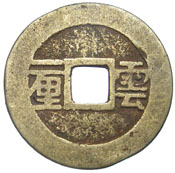
S-1404, "Yun" at right (Mi-Yun in Chihli), "Yi Li" at left.
F $8.50 VF $12.50FOURTH SERIES
The start date for the fourth series is uncertain but continues for the balance of Shun Chih's reign which ends in 1661. The mint name is in Manchurian on the left and Chinese on the right, other for coins of the Board of Revenue and Board of Works mints which have the Manchurian word for mint ("BOO") on the left and the mint name in Manchurian on the right. Schjoth suggests these last two were an issue of AD 1644 but that seem unlikely as that would suggest these two principle mints were closed during this period. Including them in series four allows a smooth transition with the coinage of K'ang-Hsi.
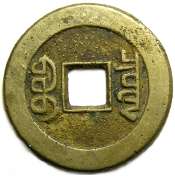
S-1405, "BOO CIOWAN" (Board of Revenue mint). The Manchurian mint name translates to Pao-Ch'uan, or "The Fountain head of the Currency".
F $2.00 VF $3.50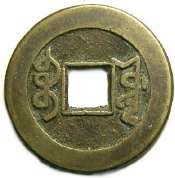
S-1406, "BOO YUWAN" (Board of Works mint). The Manchurian mint name translates to Pao-yuan or "The Source of all Currency".
F $2.00 VF $3.50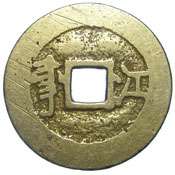
S-1407, "CHIANG" (Chiang-ning which is the city of Nanking). The Manchurian mint name translates as Giyang.
F $3.00 VF $4.50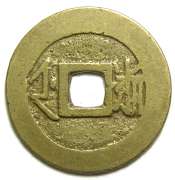
S-1408, "CHE" (Chekiang mint).
F $3.00 VF $4.50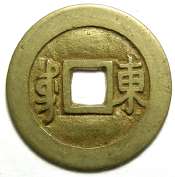
S-1409, "TUNG" (Shantung mint).
F $3.00 VF $4.50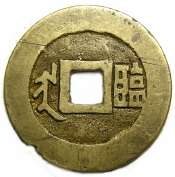
S-1410, "LIN" (Lin-ching circuit in Shantung).
F $3.00 VF $4.50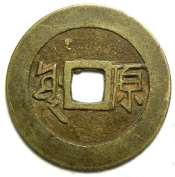
S-1411, "YUNG" (T'ai yuan Fu in Shansi).
F $3.00 VF $4.50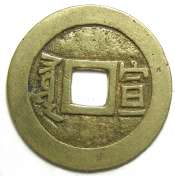
S-1412, "HSUAN" (Hsuan-Fu in Chihli).
F $3.00 VF $4.50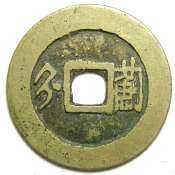
S-1413, "CHI" (Chi-chou district in Chihli).
F $3.00 VF $4.50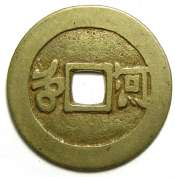
S-1414, "HO" (Honan mint).
F $3.00 VF $4.50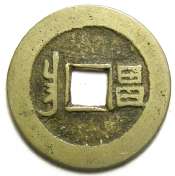
S-1415, "CHANG" (Wu-ch'ang in Hupei).
F $3.00 VF $4.50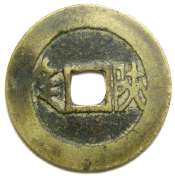
S-1416, "SHEN" (Shensi mint).
F $3.00 VF $4.50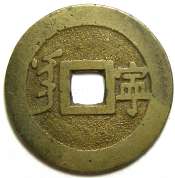
S-1417, "NING" (Ningpo mint).
F $3.00 VF $4.50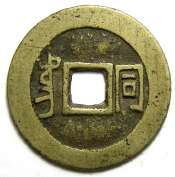
S-1418, "T'UNG" (Ta-t'ung in Shansi).
F $3.00 VF $4.50Emperor SHENG TSU
AD 1662-1722
reign title: K'ANG-HSI, AD 1662-1722

The coinage of K'ang-Hsi is a direct continuation of the last issue of Shun-chih.
PRIMARY SERIES (AD 1662-1722)
The two principal mints in Peking have "BOO" on the left, and the mint name on the right, both in Manchu script. All other mints have the mint name twice, in Manchu on the left and Chinese on the right. The size of these coins vary significantly from coin to coin. Please note that we are currently up grading this section, and for those coins for which we indicated "value not yet determined", they are not necessarily scarce and we will be adding the values in the not too distant future (a few of them are rare).

S-1419, "BOO CIOWAN" (Board of Revenue mint). The Manchu mint name translates to Pao-Ch'uan, or "The Fountain head of the Currency".
F $2.00 VF $3.00
S-1422, "BOO YUWAN" (Board of Works mint). The Manchu mint name translates to Pao-yuan or "The Source of all Currency".
F $2.00 VF $3.00
S-1423, "T'UNG" (Ta-T'ung mint in Shansi).
F $2.00 VF $3.00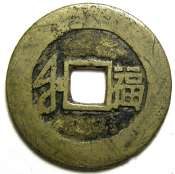
S-1424, "FU" (Fukien mint). "FU" Means "LUCK" which makes this a very popular type.
F $3.00 VF $5.00
S-1425, "LIN LIN" (Lin-ching circuit in Shantung).
F $2.00 VF $3.00
S-1426, "TUNG" (Shantung mint).
F $2.00 VF $3.00
S-1427, "CHIANG" (Chiang-ning mint at Nanking)
F $2.00 VF $3.00
S-1428, "HSUAN" (Hsuan-fu in Chihli)
F $2.00 VF $3.00
S-1429, "YUAN" (T'ai-yuan Fu in Shansi).
F $2.00 VF $3.00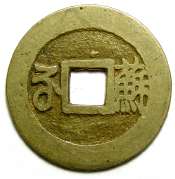
S-1430, "SU" (Soochow in Kiangsu).
F $2.00 VF $3.00
S-1431, "CHI" (Chi-Chow in Chihli).
F $2.00 VF $3.00
S-1432, "CH'ANG" (Wu-ch'ang in Hupei).
F $2.00 VF $3.00
S-1433, "NING" (Ningpo in Chekiang).
F $2.00 VF $3.00
S-1434, "HO" (Honan mint).
F $2.00 VF $3.00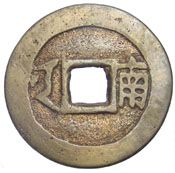
S-1435, "NAN" (Hunan mint).
RARE, Value not yet determined.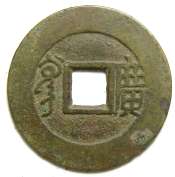
S-1436, "KUANG" (Kuangtung mint).
F $2.00 VF $3.00
S-1437, "CHE" (Chekiang mint).
F $2.00 VF $3.00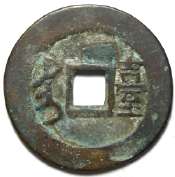
S-1438, "T'AI" (Taiwan mint).
F $100.00 VF $200.00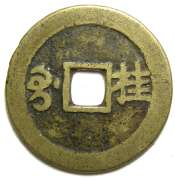
S-1439, "KUEI" (Kueilin in Kuangsu).
F $2.00 VF $3.00
S-1440, "SHEN" (Shensi mint).
F $2.00 VF $3.00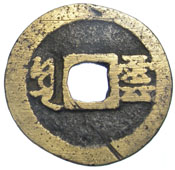
S-1441, "YUN" (Yunnan mint).
F $2.00 VF $3.00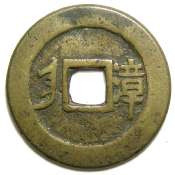
S-1442, "CHANG" (Chang-chou in Fukien).
F $2.00 VF $3.00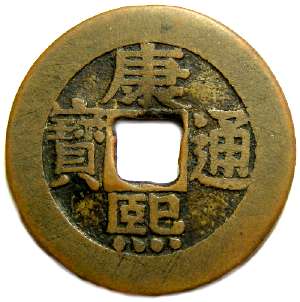
SECONDARY SERIES OF AD 1713:
These coins, which are commonly called "Lohan Coins" differ in the way the bottom character "K'ang" is drawn without the upright at the left. A myth about this variety claims they were cast from gilt bronze statues of Lohan's (attendants to Buddha), so each coin contains a trace of gold. No testing has found even a trace of gold in these, and there is nothing to support belief in this myth, which appears to originate in the mid-19th century. Burger, in his study of Ch'ing Dynasty cash, made a case for these coins being a special issue of AD 1713, to celebrate K'ang Hsi's 60th birthday.
Hartill lists these coins as having a rarity rating of 14, which means very common and somewhere in the $5.00 range. In my experience they are significantly scarcer than he suggests, and should in the $15 to $20 range. Schjoth lists these from three mints : Board of Revenue (see S-1419), Honan mint (see S-1434) and Hunan mint (see S-1435), although in the case of Honan and Hunan the mint marks are drawn slightly differently. When they become available we will add images of them.
Emperor SHIH TSUNG
AD 1723-1735
reign title: YUNG-CHENG, AD 1723-1735

From the reign of Yung-cheng, to the end of the Ch'ing dynasty, almost all of the coins conform to the standard types, with "BOO" in the reverse to the left, and the mint name in Manchurian script to the right. Mint names no longer appear in Chinese script.

S-1453, "BOO CIOWAN" (Board of Revenue mint). The Manchurian mint name translates to Pao-Ch'uan, or "The Fountain head of the Currency".
F $2.50 VF $4.00
S-1454, "BOO YUWAN" (Board of Works mint). The Manchurian mint name translates to Pao-yuan or "The Source of all Currency".
F $2.50 VF $4.00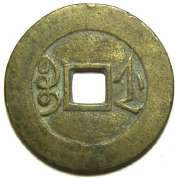
S-1455, "BOO JE" (Chekiang mint). The Manchurian mint name translates to Pao-Che.
F $2.50 VF $4.00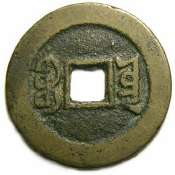
S-1456, "BOO YON" (Yunnan mint). The Manchurian mint name translates to Pao-yun.
F $4.00 VF $6.00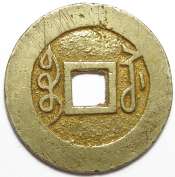
S-1457, "BOO SU" (Kiangsu Provincial mint). The Manchu mint name translates to Pao-Su.
F $4.00 VF $6.00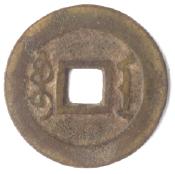
S-1458, "BOO AN" (Anhui mint). The Manchurian mint name translates to Pao-An.
F $6.00 VF $8.00FD-2280, "BOO-U" (Hubeh mint). VF $29.50
FD-2282, "BOO-HO (Hunan mint). gF $25.00
FD-2291, "BOO-JI (Shantung mint). VF $25.00
FD-2292, "BOO-JIN (Shansi mint), heavy original file marks (as made). VF $28.00
Emperor KAO TSUNG
AD 1736-1795
reign title: CH'IEN-LUNG, AD 1736-1795
 CH'IEN-LUNG | 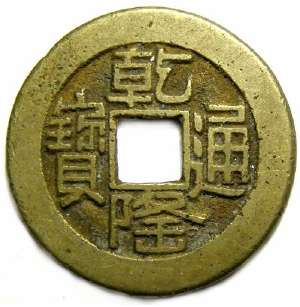 SHAN-LUNG |
Ch'ien-lung is thought of as one of the most brilliant rulers in Chinese history. He was a patron of the arts, which reached a very high level during his reign. His is also one of the few Chinese emperors to abdicate the throne, which he did to honor K'ang Hsi (his grandfather) by ending his reign just before it would have exceeded the length of K'ang Hsi's reign.
There are two basic series to the coins of Ch'ien-lung. The primary series has the regular Ch'ien-lung inscription, produced at many mints throughout his reign. The second type is referred to as the Shan-lung commemorative issue, with two upright strokes added to the bottom of the character "Lung", and is thought to have been issued during the period from his abdication in 1795 to his death in 1799. (Can anyone confirm this for me?)
PRIMARY SERIES

S-1464, "BOO CIOWAN" (Board of Revenue mint in Beijing). The Manchu mint name translates to Pao-Ch'uan, or "The Fountain head of the Currency".
F $2.00 VF $2.50
S-1466, "BOO YUWAN" (Board of Works mint in Beijing). The Manchu mint name translates to Pao-yuan or "The Source of all Currency".
F $2.00 VF $2.50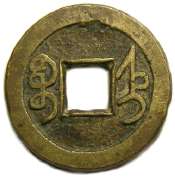
S-1467, "BOO CHI" (Chi-chou in Chihli). The Manchu mint name translates to Pao-chi.
F $2.00 VF $3.00S-1469, "BOO FU" (Fukien mint). F $2.00 VF $3.00

S-1470, "BOO JE" (Chekiang mint). The Manchu mint name translates to Pao-Che.
F $2.00 VF $3.00
S-1471, "BOO SU" (Kiangsu Provincial mint). The Manchu mint name translates to Pao-Su.
F $2.00 VF $3.00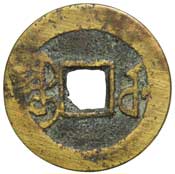
S-1472, "BOO U" (Wu Ch'ang in Hupei).
F $3.00 VF $5.00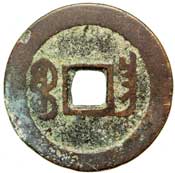
S-1475, "BOO CHANG" (Nanch'ang mint).
F $2.00 VF $3.00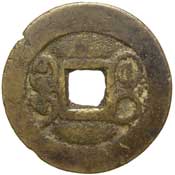
S-1476, "BOO KWANG" (Kuei-lin in Kuangsi). The mint mark on the specimen show is not well rendered.
F $2.00 VF $3.00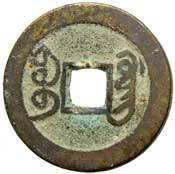
S-1477, "BOO GUANG" (Kuangtung mint).
F $2.50 VF $3.50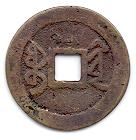
S-1478, "BOO CHIE" (Fukien Province)
F $2.50 VF $3.50
S-1480, "BOO YON" (Yunnan mint). The Manchu mint name translates to Pao-yun.
F $2.00 VF $3.00SHAN LUNG SERIES

Note the two small upright lines at the bottom of the bottom character. These Shan Lung coins were mostly issued after his abdication in 1796, but Hartill records it was used as early as 1770 at some mints in Sinkiang Province.

S-1463, Obverse: Shan-Lung. Reverse: "BOO CIOWAN" (Board of Revenue mint). The Manchurian mint name translates to Pao-Ch'uan, or "The Fountain head of the Currency".
F $3.50 VF $6.00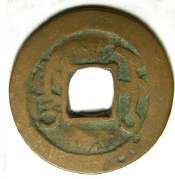
Hartill-22.433. Obverse: Shan-Lung. Reverse: "USHI USHI" (Ushi mint in Sinkiang). The name is written in Manchurian on the left, and Arabic on the right. Average (5 specimens) 24.9 mm, 4.17 grams.
F $10.00 VF $15.00Emperor JEN TSUNG
AD 1796-1820
Reign title: CHAI-CH'ING, AD 1796-1820


S-1489 (but no star), "BOO CIOWAN" (Board of Revenue mint). The Manchurian mint name translates to Pao-Ch'uan, or "The Fountain head of the Currency".
F $2.00 VF $3.00
S-1490, "BOO YUWAN" (Board of Works mint). The Manchurian mint name translates to Pao-yuan or "The Source of all Currency".
F $2.00 VF $3.00
S-1492, "BOO SU" (Kiangsu Provincial mint). The Manchu mint name translates to Pao-Su.
F $2.00 VF $4.00
S-1493 "BOO GUANG" (Kuangtung mint).
F $2.50 VF $3.50
S-1495, "BOO YON" (Yunnan mint). The Manchurian mint name translates to Pao-yun.
F $2.00 VF $3.00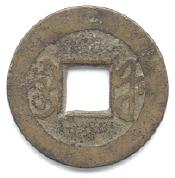
S-1500, "BOO FU" (Fukien mint). The Manchurian mint name translates to Fu as well.
F $2.00 VF $2.75
S-1501, "BOO CHI" (Chi-chou in Chihli). The Manchurian mint name translates to Pao-chi.
F $2.00 VF $3.00
S-1503, "BOO JE" (Chekiang mint). The Manchurian mint name translates to Pao-Che.
F $2.00 VF $3.00
S-1507, "BOO CHANG" (Nanch'ang mint).
F $3.00 VF $5.00
S-1509, "BOO KWANG" (Kuei-lin in Kuangsi). The mint mark on the specimen show is not well rendered.
F $2.00 VF $3.00Emperor HSUAN TSUNG
AD 1821-1850
Reign title: TAO-KUANG, AD 1821-1850


S-1512, "BOO CIOWAN" (Board of Revenue mint). The Manchu mint name translates to Pao-Ch'uan, or "The Fountain head of the Currency".
F $2.00 VF $2.50
S-1513, "BOO YUWAN" (Board of Works mint). The Manchu mint name translates to Pao-yuan or "The Source of all Currency".
F $2.00 VF $2.50
S-1514, "BOO CHI" (Chi-chou in Chihli). The Manchu mint name translates to Pao-chi.
F $2.00 VF $3.00
S-1515, "BOO SU" (Kiangsu Provincial mint). The Manchu mint name translates to Pao-Su.
F $2.50 VF $5.00S-1517, "BOO CH'ANG" (Nan-chang mint in Kiangsi). VF $2.75
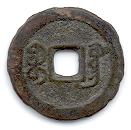
S-1522,"BOO Kuang" (Kuangtung mint).
F $2.00 VF $3.00
S-1523, "BOO KWANG" (Kuei-lin in Kuangsi). The mint mark on the specimen show is not well rendered.
F $2.00 VF $3.00S-1524, "BOO YUN" (Yunnan mint). F $3.00 VF $5.00
S-1525, "BOO T'UNG" (Probably Tung Ch'uan in Yunnan, not Ta-tung in Shansi as Schjoth lists). F $2.00
C-26-3, "BOO YON" (Yunnan mint). F $2.00
C-30-8, 10 Cash (same size as a 1 cash) of Aksu mint in Sinkiang province. The year mark 8 refers to 1828, when a revolt was suppressed in Sinkiang. Krause notes that there are modern counterfeits of this item.
VG $2.75
Emperor WEN TSUNG
AD 1851-1861
The Hsien Feng period was one of great strife in China. The Tai-ping rebellion, which lasted from 1853 to 1864 and was at least partly responsible for inflation resulting in paper money being issued for larger denomination (1000 and higher), and a variety of cast coin denominations from 1 to 1000 cash. The one cash coins have the standard two character mint marks on the reverses, while higher denominations have four characters with the extra two to show the denomination. There was also a system of obverse variations as shown below :
Reign title: HSIEN FENG, AD 1851-1861
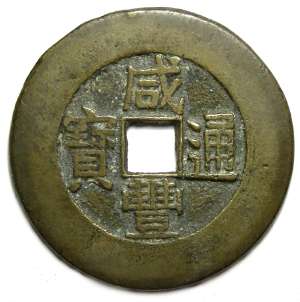 |
 |
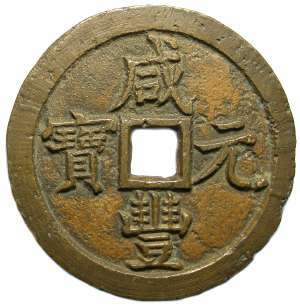 |
| OBVERSE MOSTLY ON 1 TO 5 CASH |
OBVERSE MOSTLY ON 8 TO 100 CASH |
OBVERSE MOSTLY ON 100 AND 1000 CASH |
VALUE 1 CASH

S-1534, "BOO CIOWAN" (Board of Revenue mint). The Manchu mint name translates to Pao-Ch'uan, or "The Fountain head of the Currency". These come in two sized with the smaller about 20 mm, and the larger about 24 mm.
small F $4.00 VF $6.00large F $7.50 VF $10.00

S-1535, "BOO YUWAN" (Board of Works mint). The Manchu mint name translates to Pao-yuan or "The Source of all Currency".
WE HAVE NOT YET ESTABLISHED A VALUE
S-1536, "BOO SU" (Kiangsu Provincial mint). The Manchu mint name translates to Pao-Su.
F $4.50 VF $7.50
S-1538, "BOO JE" (Chekiang mint). The Manchu mint name translates to Pao-Che.
WE HAVE NOT YET ESTABLISHED A VALUE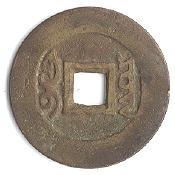
S-1544, "BOO YON" (Yunnan mint). The Manchu mint name translates to Pao-yun.
WE HAVE NOT YET ESTABLISHED A VALUEY-28.4. Ili mint in Sinkiang province........RARE. poorly cast, G $25.00
MULTIPLE CASH DENOMINATIONS
| IMAGE NOT AVAILABLE | 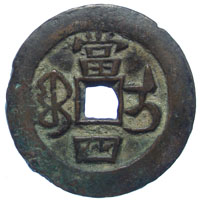 |
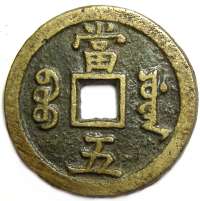 |
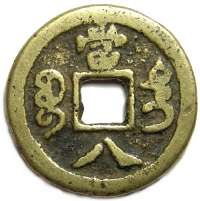 |
| 2 CASH | 4 CASH | 5 CASH | 8 CASH |
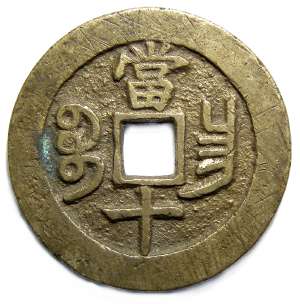 |
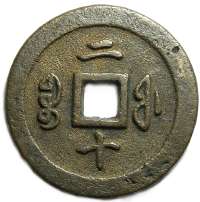 |
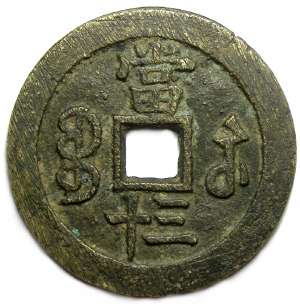 |
IMAGE NOT AVAILABLE |
| 10 CASH | 20 CASH | 30 CASH | 40 CASH |
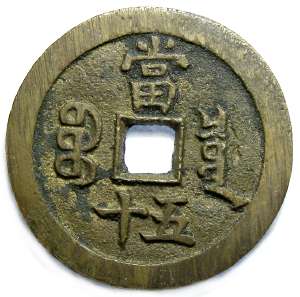 |
IMAGE NOT AVAILABLE | 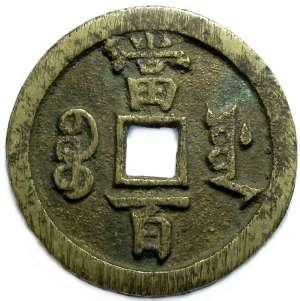 |
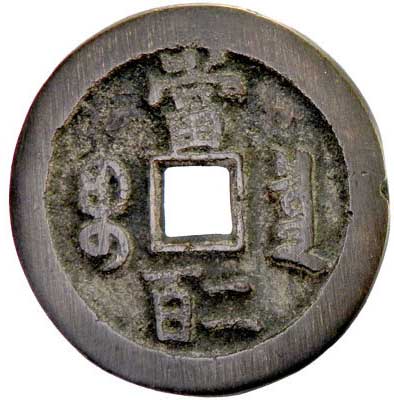 |
| 50 CASH | 80 CASH | 100 CASH | 200 CASH |
| IMAGE NOT AVAILABLE | 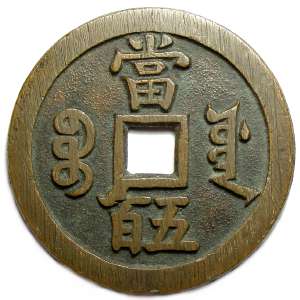 |
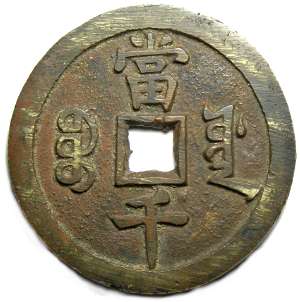 |
| 300 CASH | 500 CASH | 1000 CASH |
There are to many combinations of mint marks, denominations, sizes, etc, to even begin to include them all on this site, so we have only provided the selection above to show how the denominations are indicated via the top and bottom character on the reverse. THIS SECTION IS JUST BEING BUILT SO NOT ALL OF THE DENOMINATIONS ARE YET SHOWN. Extensive listings of this series can be round in the Krause Standard Catalogue of World Coins (19th century Volume) or CAST CHINESE COINS by David Hartill.
Local imitations of Hsien-Feng
Throughout the Chinese series there are found local imitations of Chinese coins. In some cases these coins are simply counterfeits meant to be spent alongside the official government issues. In other cases these are local coinages from other parts of southeast Asia (i.e. Sumatra) which copy Chinese issues, but were not meant to fool anyone. Unfortunately it is often difficult to tell which type one is dealing with. We suspect that the following two coins fall into the local coinage category as they are far too crude to fool anyone used to the official issues.
LOCAL IMITATION 1 CASH. G $2.00 VG $3.00
PAPER MONEY
During the time of Hsien Feng, between 1853 and 1859, there was a large issue of Government paper money with denominations relating to the Cash coins (either in Cash or Taels). These notes are somewhat scarce, but do turn up from time to time and are the only Chinese banknotes of this period that are not very rare.
Note that most genuine examples of these notes will have a small hole at the top. This is the result of having been originally issued in bundles that were tied together by a cord passed through the holes, and the hole does not affect the value in any way.
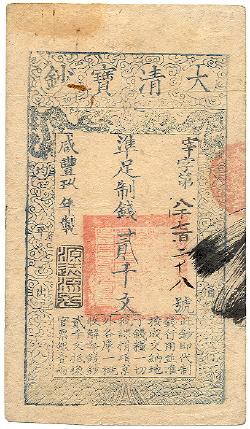
2000 cash of 1859 (Year-9). Reference Pick-A4g. The reverse is blank on these, although there can sometimes be merchant chops on them). An intact note with a light stain in the top left corner and a few brown rust stains from paper clips (more noticeable on the back). There are three major folds horizontally across the note. At the top on the note, in the middle, is a small hole as which should be present on most genuine examples of these notes 231 x 133 mm.
gVF $165.00Emperor MU TSUNG
AD 1861-1874
Mu Tsung is unusual amongst Ch'ing dynasty emperors in that he had two reign titles, although one of them was only in use for a very short period of time (probably a few weeks).
Reign title: CH'I-HSIANG, AD 1861

Coins of this reign title are very rare and most if not all examples are either seed or mother cash. Hartill (page 393) says he does not believe any circulation examples were cast, and only lists examples from Board of Works and Board of Revenue mint. Schjoth did not list any examples.
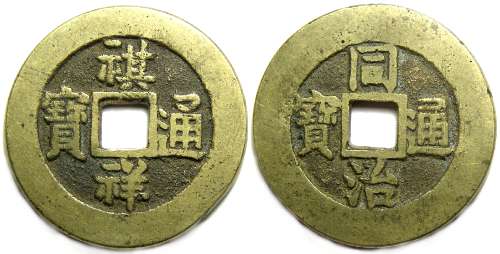
Obverse: "CH'I-HSIANG TUNG PAO". Reverse : "T'UNG-CHIH TUNG PAO". This is an odd coin, with Mu Tsung's two reign titles on opposite sides. We first we thought it might be an amulet, found it listed in the Shanghai Encyclopedia as a known coin. 27.2 m, 7.53 grams.
Very rare, and we can only guess at a value in the $2500.00 range.Reign title: T'UNG CHIH, AD 1862-1874


S-1554. C-4-17, "BOO JE" (Chekiang mint). The Manchu mint name translates to Pao-Che.
WE HAVE NOT YET ESTABLISHED A VALUE
S-1556, "BOO SU" (Kiangsu Provincial mint). The Manchu mint name translates to Pao-Su.
F $8.50 VF $11.50
S-1557, "BOO FU" (Fukien mint). The Manchu mint name translates to Fu as well.
WE HAVE NOT YET ESTABLISHED A VALUEC-15-7, "BOO GUNG" (Kiangsi mint). F $4.00 VF $5.50 XF $11.00
C-24-8, "BOO CUWAN" (Szechuan mint). VG $9.50 F $15.00

C-26-7, "BOO YON" (Yunnan mint). The Manchu mint name translates to Pao-yun.
VG $3.50 F $5.00T'ung Chih also issued some larger denomination coins in both brass and copper, in 4, 5 and 10 cash denominations. The 4 and 5 cash are rare and seldom seen, but the 10 cash turn up fairly often.
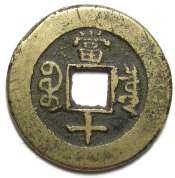
S-1600. 10 cash from the Board of Works mint. These come in a variety of sizes. The specimen illustrated is 7.15 grams, 28.6 mm.
F $7.50 VF $11.50Emperor TE TSUNG
AD 1875-1908
Reign title: KUANG-HSU, 1875-1908
 |
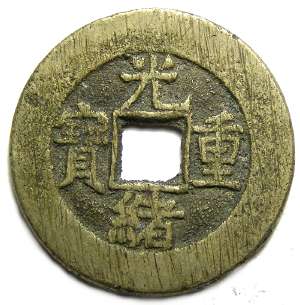 |
| OBVERSE ON 1 CASH |
OBVERSE ON 10 CASH |

As c-1-16 but 19 mm. "BOO CIOWAN" (Board of Revenue mint). The Manchu mint name translates to Pao-Ch'uan, or "The Fountain head of the Currency".
gVF $5.00 AS CAST $8.50
C-2-15, "BOO YUWAN" (Board of Works mint). The Manchu mint name translates to Pao-yuan or "The Source of all Currency".
F $4.50 VF $7.50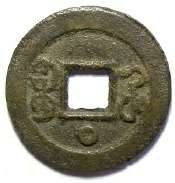
Hartill 22.1352, "BOO HO" (Honan mint). The Manchu mint name translates to Pao-Ho. This particular example has a small circle at the bottom of the reverse, and there are other types with other symbols at the top or bottom of the reverse. This mint operated between 1898 and 1905.
F $6.50 VF $8.50
Hartill 22.1419, "BOO CHI" (Chi-chou, which is the Peiyang arsenal mint in Chihli). The Manchu mint name translates to Pao-chi. Coins of this type will often be poorly cast and poorly finished and even when nearly as cast will look to be Fine or VF. This mint was opened in 1898.
F $4.00 VF $6.50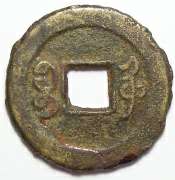
Hartill 22.1426 to 22.1428. "BOO GU" (Dagu, which is the Dagu Imperial Navy Yard in Chihli). The Manchu mint name translates to Pao-Gu. Coins of this type will often be poorly cast and poorly finished and even when nearly as cast will look to be Fine or VF. This mint was opened in 1898.
F $6.00 VF $8.50C-10-25, "BOO FU" (Fukien mint). F $4.00 VF $7.00

C-26-7, "BOO YON" (Yunnan mint). The Manchu mint name translates to Pao-yun.
F $7.50 VF $12.50In 1898 and 1899, a series of 1 cash coins were cast at the Board of Revenue and Board of Works mints with and extra character at the top to indicating the quarter of the year in which they were cast. Hartill lists seven different in the following order : YU, ZHOU, RI, LEI, LAI, WANG and one with just a DOT, but does not indicate if this is in the sequence in which they were used. These are small coins, generally around 19 mm. All are of the same value at : F $10.00 VF $15.00
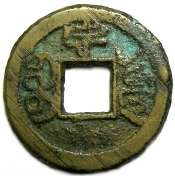 | 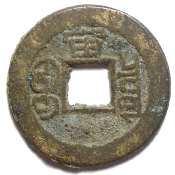 |
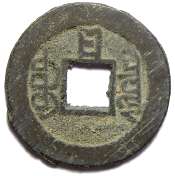 | image not yet available |
| YU | ZHOU | RI | LEI |
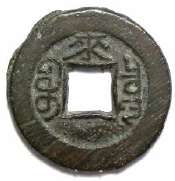 | 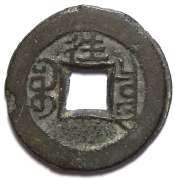 | image not yet available | |
| LAI | WANG | dot |
MACHINE STRUCK CASH
During the Kuang-hsu period the first machine made cash coins of China were struck. They were struck in a very yellow brass, and tend to be very well made, but do not appear to have been too popular as they are normally seen with very little wear on them, showing they did not circulate widely. Most were made in the Kwangtung province, and were probably first struck in 1889.
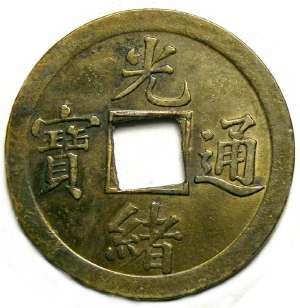
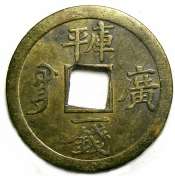
Y-189, "Kuang T'ung" (Kwangtung mint money) at the sides. The character at the bottom means 1 cash, but I have not yet determined the meaning of the two characters at the top. This type is reported to have been struck only in 1889.
VF $1.50 XF $2.50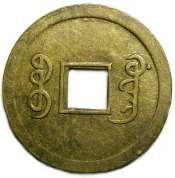
Y-190, "BOO Kuang" (Kwangtung mint) at the sides. This type was struck from 1890 to 1908.
VF $1.00 XF $2.00Emperor PUYE
AD 1908-1912
Puye was the last emperor of China. He was only three years old when he come to the throne, then was forced to abdicate to the forces of the Republic 1912, but continued to live in the Imperial palace until 1924. In 1932 when the Japanese made him president of Manchukuo, and then changed his title to Emperor of Manchukuo in 1934, with reign title: K'ANG-TE.
Reign title: HSUAN-T'UNG, 1908 - 1912


C-1-19.1 (small) and C-1-19.2 (large) 1 cash. Obverse: Hsuan-T'ung type. Reverse: "BOO" on the left and "CIOWAN" (Board of Revenue mint) on the right. Normally seen nearly "as cast" but are normally roughly finished.
small about 19.1 mm gVF $9.50 XF $12.50larger about 24 mm gVF $30.00 XF $45.00
The use of cast cash coinage all but came to an end shortly after 1912, so these Hsuan-T'ung coins saw little use and are normally seen in a grade of XF to near mint state condition with clear original file marks. Coins appearing to grading F or VF are usually just poor castings rather than worn coins.
TAI PING REBELS
Tai Ping Rebel fought a civil war with the Ching Dynasty from 1853-1864, making both coins and paper money. The paper money is rare and genuine examples seldom offered, but the coins turn up from time to time. When attributing a coin to this period, it is important to note that while there are many different types not listed here, all have characters on the reverse and any that are blank on the reverse, date to the reign of the North Sung Emperor T'ai Tsung, AD 976 to 997.
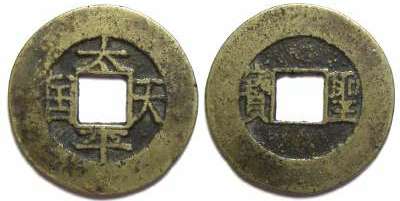
S-1606. 1 cash. Obverse: "T'AI-P'ING T'IEN-KUO" (T'ai P'ing Celestial State or T'ai P'ing Heavenly Kingdom). Reverse: "SHENG-PAO" (Sacred Currency). This issue is often rough or poorly cast. Average (1 specimen) 22.3 mm, 3.54 grams.
F $30.00 VF $50.00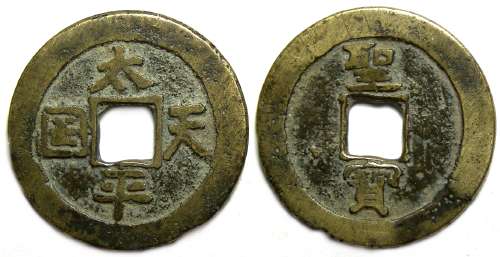
S-1607. 1 cash. Obverse: "T'AI-P'ING T'IEN-KUO" (T'ai P'ing Celestial State or T'ai P'ing Heavenly Kingdom). Reverse: "SHENG-PAO" (Sacred Currency).
F $30.00 VF $50.00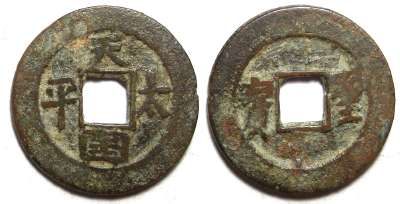
Hartill-23.19. 1 cash. Obverse: "T'IEN-KUO T'AI-P'ING" (The Celestial State of T'ai P'ing). Reverse: "SHENG-PAO" (Sacred Currency). Average (1 specimen) 25.0 mm, 4.87 grams.
F $30.00 VF $50.00PALACE CASH
Palace cash should may or may not be considered a type of amulet. According to the Krause catalogue of world coins, these were made as New Years gifts to people in the Imperial Palace, usually eunuchs and guards, who hung them below lamps. Hartill, in "Qing Cash" (Royal Numismatic Society, 2003) agrees they were handed out as gifts in the Palace, but only on the establishment of each new Reign title, and were wrapped in red cloth. I am inclined to accept David Hartill's explanation which only involves them being cast once at the beginning of each reign title, rather than annually at New Years, as this is consistent with their relatively rarity. Usually between 30 and 40 mm, with the first issue being under Ch'ien-lung in 1736, and continuing for each succeeding Emperor to the end of the Ching Dynasty.
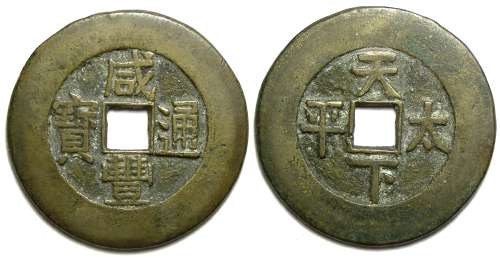
Obverse: "HSIEN FENG TUNG PAO". Reverse : "T'EIN-HSIA TAI'PING" meaning "peace under heaven".
WE HAVE NOT YET ESTABLISHED A VALUE
Copyright © 1997 - 2025 R & T Enterprises Ltd.